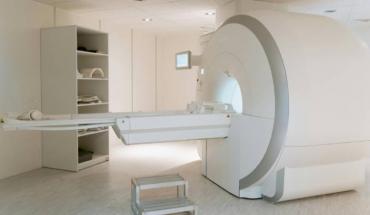Carotid Ultrasound
Carotid Artery Duplex Scan
(Carotid Ultrasound, Vascular Ultrasound Study, Carotid Artery Doppler Sonography)
Procedure overview
A carotid artery duplex scan is a type of vascular ultrasound study done to assess the blood flow of the arteries that supply blood from the heart through the neck to the brain. There are six carotid arteries--the right and left common carotid arteries, which divide and form the right and left internal carotid arteries and the right and left external carotid arteries. One pair (external and internal) is located on each side of the neck.
A carotid artery duplex scan is a noninvasive (the skin is not pierced) procedure. The term "duplex" refers to the fact that two modes of ultrasound are used--Doppler and B-mode. The B-mode transducer (like a microphone) obtains an image of the carotid artery being studied. The Doppler probe within the transducer evaluates the velocity and direction of blood flow in the vessel.
A transducer sends out ultrasonic sound waves at a frequency too high to be heard. When the transducer is placed on the carotid arteries at certain locations and angles, the ultrasonic sound waves move through the skin and other body tissues to the blood vessels, where the waves echo off of the blood cells. The transducer picks up the reflected waves and sends them to an amplifier, which makes the ultrasonic sound waves audible. Absence or faintness of these sounds may indicate an obstruction to the blood flow.
A related procedure that may be performed to further evaluate the carotid artery and its branches is cerebral arteriogram. Please see this procedure for more information.
Reasons for the procedure
| |
| Click Image to Enlarge |
A carotid artery duplex scan is used to assess occlusion (blockage) or stenosis (narrowing) of the carotid arteries of the neck and/or the branches of the carotid artery. Plaque (a buildup of fatty materials), thrombus (blood clot), and other substances in the blood stream may cause a disturbance in the blood flow through the carotid arteries.
When the carotid arteries become blocked, symptoms may include dizziness, confusion, drowsiness, headache, momentary blindness in one eye, and/or a brief loss of ability to speak or move. These symptoms may indicate early warning signs of a possible stroke (brain attack, or cerebrovascular accident [CVA]).
A carotid artery duplex scan may also be performed when no symptoms of occlusion are present, yet an abnormal blood flow sound called a bruit (pronounced "BROO-ee") is heard with a stethoscope over the artery. This may indicate a possible condition of abnormal blood flow in the artery.
Additional reasons for the procedure include, but are not limited to, the following:
-
Evaluation of previous procedures to restore blood flow to the area (such as an angioplasty to open up an artery that was blocked or surgery to bypass a blocked artery)
-
Evaluation of carotid blood flow prior to a major cardiovascular surgical procedure, such as coronary artery bypass grafting or heart valve repair/replacement
-
Location of a hematoma (a collection of clotted blood that may slow and eventually stop blood flow)
-
Detect dissection of the carotid artery, a split between layers of the artery wall that may lead to obstruction of blood flow or a weakening of the wall of the artery
There may be other reasons for your doctor to recommend a carotid artery duplex scan.
Risks of the procedure
There is no radiation used and generally no discomfort from the application of the ultrasound transducer to the skin.
There may be risks depending on your specific medical condition. Be sure to discuss any concerns with your doctor prior to the procedure.
Certain factors or conditions may interfere with the results of the test. These include, but are not limited to, the following:
-
Severe obesity
-
Irregular heart rhythms (arrhythmias)
-
Cardiac disease
Before the procedure
-
Your doctor will explain the procedure to you and offer you the opportunity to ask any questions that you might have about the procedure.
-
You may be asked to sign a consent form that gives your permission to do the procedure. Read the form carefully and ask questions if something is not clear.
-
Generally, no prior preparation, such as fasting or sedation, is required.
-
Your doctor may give you specific instructions about smoking and consuming caffeine. You may be asked to refrain from smoking for at least two hours before the test, as smoking causes blood vessels to constrict. You may also be asked to refrain from consuming caffeine in any form for about two hours prior to the test.
-
Based on your medical condition, your doctor may request other specific preparation.
During the procedure
| |
| Click Image to Enlarge |
A carotid artery duplex scan may be performed on an outpatient basis or as part of your stay in a hospital. Procedures may vary depending on your condition and your doctor's practices.
Generally, a carotid artery duplex scan follows this process:
-
You will be asked to remove any clothing, jewelry, or other objects that may interfere with the scan.
-
If you are asked to remove clothing, you will be given a gown to wear.
-
You will lie on an examination table with your neck slightly extended (bent backward).
-
A clear gel will be placed on the skin at various locations on the carotid arteries.
-
The Doppler transducer will be pressed against the skin and moved around over the area of the artery being studied.
-
When blood flow is detected, you will hear a "whoosh, whoosh" sound. The probe will be moved around to compare blood flow in different areas of the artery. Both sides of the neck will be examined.
-
Once the procedure has been completed, the gel will be wiped off.
The technologist will use all possible comfort measures and complete the procedure as quickly as possible to minimize any discomfort.
After the procedure
While the carotid artery duplex scan procedure itself causes no pain, having to lie still for the length of the procedure might cause slight discomfort.
There is no special type of care required after a carotid artery duplex scan. You may resume your usual diet and activities unless your physician advises you differently.
Your doctor may give you additional or alternate instructions after the procedure, depending on your particular situation.
Related Questions
Mantoux Test Query
- 3481 Days ago
- Tests & Procedures
My Rheumatoid Factor is - H 74 IU/mL
- 3639 Days ago
- Tests & Procedures
Suffering from piles
- 3760 Days ago
- Tests & Procedures
widal positive
- 3874 Days ago
- Tests & Procedures
Whitish viscosity
- 3883 Days ago
- Tests & Procedures
LINAC procudure, 3DRT and IMRT
- 3897 Days ago
- Tests & Procedures
Ecg of heart showed T wave changes
- 3938 Days ago
- Tests & Procedures
CT Coronary Angiography
- 3922 Days ago
- Tests & Procedures





















